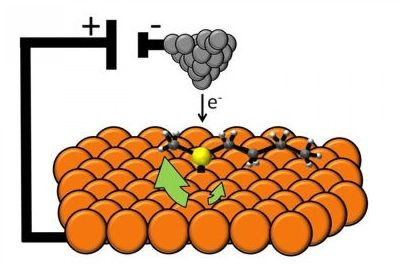Scientists Make Electric Motor From Just 1 Molecule, Breaks Record [VIDEO]

The world's tiniest electric motor has been created from a single molecule, giving hope for scientists for developing new devices that can be applied in medicine and engineering.
A team of chemists at Tufts University have developed the microscopic single-molecule motor measuring one nanometer across, and this breathtaking achievement is likely to be recognized by Guinness World Records.
One nanometer is 60,000 times smaller than a single strand of a human hair, and the current world record is a 200 nanometer motor.
There has been significant progress in the construction of molecular motors powered by light and by chemical reactions, but this is the first time that electrically-driven molecular motors have been demonstrated, despite a few theoretical proposals, said E. Charles H. Sykes, Ph.D., associate professor of chemistry at Tufts who led the team.
We have been able to show that you can provide electricity to a single molecule and get it to do something that is not just random.
The team used a scanning tunnelling microscope that shows molecules through electrons instead of light, and managed to spin a single butyl methyl sulfide molecule. They used the metal tip of the microscope to provide an electrical charge to the molecule that had been placed on a copper surface.
This molecule has carbon and hydrogen atoms radiating from it to form what look like two arms, with four carbons on one side and one on the other. These carbon chains were free to rotate around the sulphur-copper bond at speeds of up to 120 rpm.
Scientists found that a freezing minus 268 degrees centigrade proved ideal for tracking the motor's motion as direction and speed were affected by temperature.
At higher temperatures, the motor spins too fast to observe and control.
It's not that we couldn't work at a higher temperature - it's just that too much is happening. At that speed, it's just a blur, said Sykes.
Once we have a better grasp on the temperatures necessary to make these motors function, there could be real-world application in some sensing and medical devices which involve tiny pipes, said Sykes.
Friction of the fluid against the pipe walls increases at these small scales, and covering the wall with motors could help drive fluids along.
To power individual molecules, electricity gives higher precision than light and chemicals, because you're driving billions of them at a time, explained Sykes to the BBC. With electricity, we can land just on top of one molecule, measure it and spin it, said Sykes, adding that it is the ultimate way to drive molecules precisely. The new method gives great hope for scientists in advancing nano-sensors and in medicine.
By slightly modifying the molecule, the molecular electric motors could be used to generate microwave radiation or to couple into nano-electromechanical systems (NEMS).
The next thing to do is to get the thing to do work that we can measure - to couple it to other molecules, lining them up next to one another so they're like miniature cog-wheels, and then watch the rotation propagation down the chain, said Sykes.
© Copyright IBTimes 2024. All rights reserved.





















